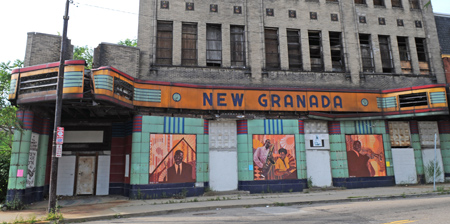
Face-lift planned for Hill landmark
By Bonnie Pfister
TRIBUNE-REVIEW
Tuesday, July 29, 2008
Its facade of green, gold and blue is crumbling. Its fourth floor and parts of its roof have collapsed. Front entrances are bricked up and painted over.

The Hill Community Development Corp., which purchased 80-year-old New Granada Theater in 1995, expects to receive a $500,000 grant from the state's Redevelopment Assistance Capital Program to rehabilitate the building. It will be paired with a $250,000 grant received from The Heinz Endowments in May 2007. - Andrew Russell/Tribune Review
Light bulbs and tangled wires hang loose from the now-skeletal marquees at Centre Avenue and Devilliers Street, which once proclaimed the appearance of such jazz legends as Ella Fitzgerald, Louis Armstrong and Dizzy Gillespie.
The Hill Community Development Corp., which purchased the building in 1995, expects to receive a $500,000 grant from the state’s Redevelopment Assistance Capital Program. It will be paired with a $250,000 grant received from The Heinz Endowments in May 2007.
Development corporation chair Marimba Milliones said initial preservation work will begin later this year, although another estimated $1.25 million to complete stabilization is needed.”We need to secure the roof, and work on bracing the left side of the structure,” Milliones said. Community input — and more fundraising — would precede redevelopment of the building.
“Given its history, we’d like to see . . . a percentage of that space used to celebrate the cultural legacy of the Hill District,” Milliones said. “But it’s a huge building. Our opportunity for redevelopment is very versatile.”
Designed by black architect Louis A.S. Bellinger, the building was originally a lodge for the Knights of Pythias, a fraternal order of black construction workers, according to the Pittsburgh History & Landmarks Foundation. A second-floor ballroom began hosting prominent black musicians, with Duke Ellington crowned the “King of Jazz” in a 1932 concert, part of a pioneering national radio broadcast.
In 1938, it became a commercial theater, renamed the New Granada with a polychromatic Art Moderne facade — the more horizontal-oriented successor to Art Deco, known for its curved walls and canopies.
It was designated a city historic landmark in 2004, nominated by the Young Preservationists Association of Pittsburgh. With two grocers vying to build a supermarket nearby, association CEO Dan Holland said the neighborhood could become increasingly viable for would-be New Granada investors.
“It’s probably the most important building in the Hill District — partly due to location, but also as a symbol,” Holland said. “It would be symbolic for the Hill’s renaissance to see that building restored.”
Bonnie Pfister can be reached at bpfister@tribweb.comor 412-320-7886.
